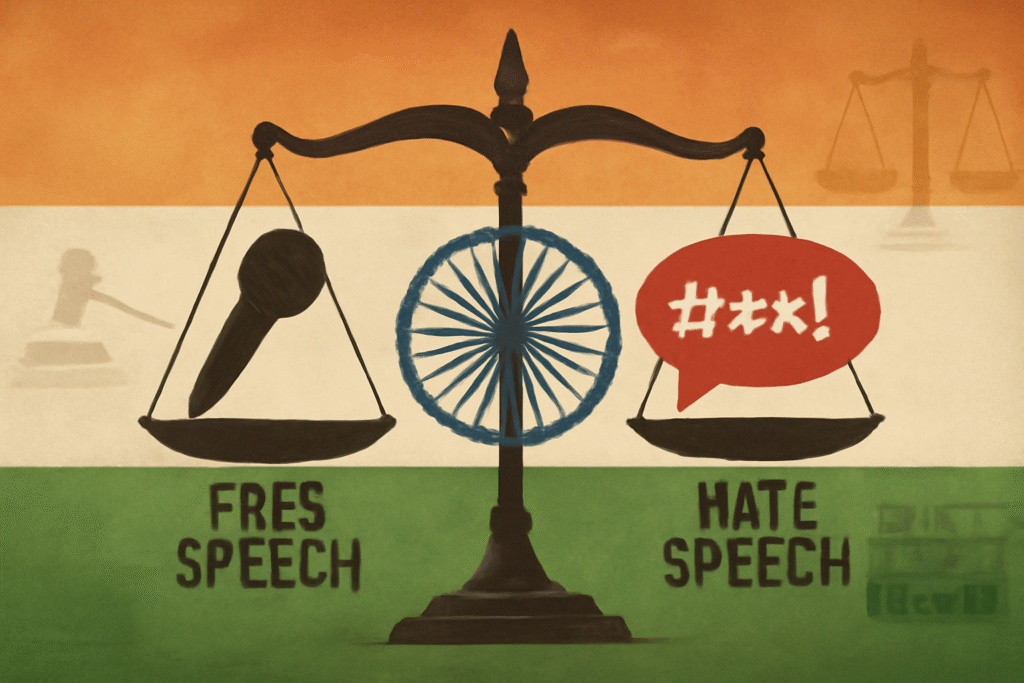Published On: September 24th 2025
Authored By: A. Mahalakshmi
Sathyabama University
ABSTRACT
Plea bargaining is a legal process that permits an accused individual to negotiate for a lighter sentence or lesser charges in return for a voluntary confession of guilt. Initially incorporated into the Indian legal framework through the Criminal Law (Amendment) Act, 2005, it has now been preserved and slightly improved under the Bharatiya Nagarik Suraksha Sanhita, 2023 (BNSS), which supersedes Chapter XXIA of the Criminal Procedure Code, 1973. This essay examines the evolving scope of plea bargaining within the new legal structure, emphasizing its relevance, exceptions, and procedural framework. It explores the advantages of plea bargaining, including expedited trials, reduced case backlogs, victim compensation, and efficient resource utilization. Simultaneously, it addresses critical challenges, including concerns about voluntariness, potential exploitation by repeat offenders, and insufficient public awareness. While the BNSS adopts a careful and structured approach, it has significant potential to alleviate the burden on India’s overloaded criminal justice system if implemented with appropriate safeguards and transparency.
INTRODUCTION
Plea bargaining, a concept relatively new to Indian criminal jurisprudence, serves as a pragmatic approach to resolving criminal cases without prolonged trials. Introduced through the Criminal Law (Amendment) Act, 2005, and originally codified under Sections 265A to 265L of the Code of Criminal Procedure (CrPC), plea bargaining is now governed by Sections 290 to 303 of the BNSS. This mechanism allows an accused to voluntarily plead guilty in exchange for a lesser sentence or reduced charge, aiming to address judicial backlog challenges, reduce case pendency, and provide faster resolution for certain categories of offenses.
While this framework offers notable benefits including judicial efficiency, reduced litigation costs, and speedy justice, its practical implementation faces systemic challenges such as lack of awareness, risks of coercion, and unequal access to justice. Understanding the scope and limitations of plea bargaining is crucial for evaluating its role in India’s evolving criminal justice landscape. This analysis examines the current legal framework, explores its benefits, and challenges, and assesses its potential impact on the Indian judicial system.
SCOPE OF PLEA BARGAINING IN INDIA
Statutory Framework
Plea bargaining is now governed by Chapter XXIII (Sections 290 to 303) of the Bharatiya Nagarik Suraksha Sanhita, 2023 (BNSS), which replaces Chapter XXIA of the Code of Criminal Procedure, 1973. The provision retains much of the structure of the earlier law while modernizing the language and procedural requirements.
Applicability Criteria
Plea bargaining continues to apply only in cases where the maximum punishment does not exceed seven years of imprisonment. It remains limited to relatively minor, non-heinous offenses, with the objective of resolving such cases efficiently and reducing the burden on the judicial system.
Excluded Offenses
The BNSS continues to exclude the following categories of offenses from plea bargaining:
- Offenses that affect the socio-economic condition of the country (as notified by the government)
- Offenses against women
- Offenses against children under the age of 14 years
Additionally, offenses attracting life imprisonment or the death penalty remain outside the scope of this provision.
Initiation Process
Only the accused can initiate the plea-bargaining process by filing an application before the Magistrate. The court must ensure that the application is made voluntarily, with full understanding of the consequences, and free from coercion or undue pressure.
Judicial Role and Settlement Process
The court conducts a preliminary inquiry in camera (privately) to confirm voluntariness. If satisfied, the court facilitates a mutually satisfactory disposition involving the prosecution, the accused, and the victim (where applicable). The outcome may involve reduced charges, lighter punishment, or compensation to the victim.
Practical Categories of Plea Bargaining
While the BNSS does not formally classify plea bargaining into distinct types, in practice it may involve:
- Sentence Bargaining: Agreeing to a lesser sentence for the same charge.
- Charge Bargaining: Pleading guilty to a lesser offense.
- Fact Bargaining: Agreeing on certain facts (rarely used in India)
Practical Scope and Application
The scope of plea bargaining under the current law remains conservative yet practically useful. It is primarily applicable to:
- Minor criminal cases such as simple hurt, criminal trespass, public nuisance, and dishonour of cheques
- First-time offenders
- Cases pending at the trial stage.
- Cases involving undertrial prisoners, thereby helping reduce court backlog and ensuring speedy justice.
BENEFITS OF PLEA BARGAINING IN INDIA
The introduction of plea bargaining in India was designed to address the persistent issue of judicial delays, particularly in criminal cases. When implemented properly, the benefits are significant for the judiciary, the accused, victims, and society at large.
Expedited Justice and Case Disposal
One of the most significant advantages of plea bargaining is the speedy resolution of criminal cases. India’s judicial system faces a burden of over 4 crore pending cases, many of which involve criminal matters. Plea bargaining allows for case disposal without full-fledged trials, thus reducing pendency and enabling courts to focus on more serious offenses.
Relief for Undertrial Prisoners
A substantial percentage of inmates in Indian jails are undertrial prisoners who may remain incarcerated for years due to slow trial processes. Plea bargaining offers a quicker route to sentencing, allowing them to serve lesser sentences and reintegrate into society more expeditiously.
Reduction in Litigation Costs
For both the state and the accused, a complete criminal trial is time-consuming and expensive. Plea bargaining saves judicial time, legal fees, and law enforcement resources. This benefit is particularly significant for economically disadvantaged accused persons.
Victim Participation and Compensation
Unlike in many other countries, the Indian model of plea bargaining includes meaningful victim participation. The victim has the right to be heard and to accept or reject the proposed disposition. Compensation to the victim may form part of the negotiated outcome, providing a measure of justice and closure.
Prison Decongestion
With overcrowding in Indian prisons becoming a serious human rights concern, plea bargaining can reduce the influx of new inmates by resolving minor criminal cases efficiently, thereby easing the burden on the prison system.
Encouraging Accountability
By admitting guilt voluntarily, the accused is required to take responsibility for their actions. This may foster remorse and aid in rehabilitation, particularly beneficial for first-time offenders.
Mitigation of Witness-Related Issues
In regular trials, delays often lead to witness fatigue, hostility, or unavailability, weakening the prosecution’s case. Plea bargaining bypasses these issues entirely, providing a more efficient route to justice.
CHALLENGES OF PLEA BARGAINING IN INDIA
Risk of Coercive or Involuntary Pleas
A major concern is the possibility of coercion, particularly affecting uneducated, economically disadvantaged, or socially marginalized accused persons who may not fully understand the consequences of pleading guilty. There is inherent danger that an accused might be pressured by law enforcement, prosecution, or even legal counsel to opt for plea bargaining merely to avoid lengthy trials.
Potential Compromise on Justice and Deterrence
Critics argue that plea bargaining may result in disproportionately lighter punishments for guilty individuals, undermining the principle of proportional sentencing. This could reduce the deterrent effect of criminal law and create public perception that offenders can “negotiate” their way out of appropriate justice.
Unequal Bargaining Power
An inherent imbalance exists between the prosecution and the accused. Prosecutors may use the threat of longer sentences to pressure accused persons into accepting plea deals, even when the accused is innocent or has valid defences. This dynamic undermines the fairness of the criminal justice process.
Limited Public Awareness and Utilization
Plea bargaining remains underutilized in India, partly due to insufficient awareness among legal practitioners, prison inmates, and the general public. Greater outreach and training initiatives are needed to ensure that eligible accused persons are informed of this option.
Restrictive Legislative Scope
The Indian framework limits plea bargaining to non-serious offenses, excluding many white-collar crimes and cases that could benefit from expedited resolution. By excluding offenses against women and children or those affecting socio-economic conditions, the law limits the overall impact on pendency reduction.
Inadequate Legal Aid Infrastructure
For plea bargaining to function effectively, accused persons must have access to competent legal representation. However, India’s legal aid system is often understaffed and underfunded, making it difficult for economically disadvantaged defendants to receive proper legal guidance during plea negotiations.
Transparency and Accountability Concerns
While supervised by the court, the procedure often occurs in closed settings. Without proper recording or monitoring, it may lead to abuse of discretion, corruption, or informal settlements that escape public scrutiny.
Judicial Reluctance and Inconsistent Application
Many judges remain hesitant to embrace plea bargaining, given its departure from traditional trial-based justice. This results in inconsistent application across different courts and jurisdictions, undermining the system’s reliability and predictability.
CONCLUSION
Plea bargaining was introduced with the vision of enhancing efficiency within India’s criminal justice system. While it demonstrates promise for reducing judicial delays and streamlining case resolution, its application faces systemic challenges including insufficient awareness, potential coercion, and unequal access to legal resources.
For plea bargaining to function effectively and equitably, it is essential to implement comprehensive awareness initiatives, establish robust procedural safeguards, and ensure uniform judicial standards across all courts. Additionally, expanding legal aid infrastructure and providing adequate training for legal practitioners will be crucial for the system’s success.
With these necessary reforms, plea bargaining can evolve into a fair and reliable tool for justice that balances efficiency with the fundamental rights of all stakeholders. The BNSS framework provides a solid foundation, but its success will ultimately depend on thoughtful implementation and continuous refinement based on practical experience.
REFERENCES
- Rai, Kailash. (2023). The Code of Criminal Procedure. Central Law Publications.
- Gaur, K.D. (2022). Textbook on the Indian Penal Code. LexisNexis.
- Ratanlal & Dhirajlal. (2023). The Code of Criminal Procedure. LexisNexis.
- Paranjape, N.V. (2023). Criminal Procedure Code. Central Law Agency.
- Legal Services India. “Nature and Scope of Plea Bargaining.” Available at: https://www.legalservicesindia.com/article/2030/Nature-and-Scope-of-Plea-Bargaining.html
- Indian Journal of Training & Research. “Plea Bargaining.” Available at: https://ijtr.nic.in/PLEA%20BARGAINING.pdf
- LawCtopus. “Plea Bargaining Mechanism Types Scope.” Available at: https://lawctopus.com/clatalogue/clat-pg/plea-bargaining-mechanism-types-scope/
- Xperts Legal. “Concept of Plea Bargaining.” Available at: https://xpertslegal.com/blog/concept-of-plea-bargaining/




